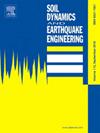基于简化方法和一维有效应力地响应分析的2017年浦项地震液化潜力评价——以韩国浦项地震为例
IF 4.2
2区 工程技术
Q1 ENGINEERING, GEOLOGICAL
引用次数: 0
摘要
我们评估了2017年韩国浦项地震中观测到的六个剖面的液化潜力,该地震的矩震级(M)为5.5。其中两个地点位于距离震中2公里以内,而第三个地点位于距离震中8公里的地方。为了预测液化的发生,我们使用了基于简化循环应力的方法和一维有效应力(ES)地面反应分析(GRA)。将简化方法应用于M <的主要不确定性来源;7.5级地震决定了震级比例系数(MSF)。我们测试了四个经验的MSF关系。所有MSF方程对输入运动的峰值地面加速度(amax) >;0.15g和循环应力比(CSR) >;0.2. 然而,在amax <;0.15g和CSR <;0.2,强度相关的MSF提供了最可靠的液化潜力预测,而其他三个方程高估了循环阻力比。ES GRAs是在一维GRA程序中使用基于累积应力和应变的孔隙压力模型进行的。与基于循环应力的方法相比,ES GRA的一个关键优势是它不需要经验MSF。基于应力的模型比基于应变的模型估算出更高的孔隙压力,对6个剖面中的5个给出了正确的预测。基于应变的模型对剪切波速(VS)剖面高度敏感,倾向于低估amax <的孔隙压力;0.15g,建议谨慎使用此模型进行中等强度运动。在应用于基于应变的模型的两组输入参数中,以VS为条件的输入参数产生的孔隙压力预测值最低,因此不推荐使用。本文章由计算机程序翻译,如有差异,请以英文原文为准。
Assessment of liquefaction potential using simplified method and one-dimensional effective stress ground response analysis during 2017 Pohang earthquake in South Korea: A case study
We assessed the liquefaction potentials at six profiles where sand boils were observed during the 2017 Pohang earthquake in South Korea, which had a moment magnitude (M) of 5.5. Two of the sites are located within 2 km from the epicenter, whereas the third one is located 8 km away. To predict the onset of liquefaction, we used both the simplified cyclic stress-based method and one-dimensional (1D) effective stress (ES) ground response analysis (GRA). A major source of uncertainty in applying the simplified method to M < 7.5 earthquakes is determining the magnitude scaling factor (MSF). We tested four empirical MSF relationships. All MSF equations produced similar predictions for profiles where peak ground acceleration of input motion (amax) > 0.15g and cyclic stress ratio (CSR) > 0.2. However, at profiles with amax < 0.15g and CSR < 0.2, the intensity-dependent MSF provided most reliable predictions of the liquefaction potential, whereas the other three equations overestimated the cyclic resistance ratio. The ES GRAs were conducted using accumulated stress- and strain-based pore pressure models implemented in a 1D GRA program. One key advantage of the ES GRA over the cyclic stress-based method is that it does not require an empirical MSF. The stress-based model produced higher pore pressure estimates than the strain-based model, yielding correct predictions for five out of six profiles. The strain-based model, highly sensitive to the shear wave velocity (VS) profile, tended to underestimate pore pressure for amax < 0.15g, suggesting caution when using this model for moderate-intensity motions. Among the two sets of input parameters applied to the strain-based model, the set conditioned on VS yielded the lowest pore pressure predictions and is therefore not recommended.
求助全文
通过发布文献求助,成功后即可免费获取论文全文。
去求助
来源期刊

Soil Dynamics and Earthquake Engineering
工程技术-地球科学综合
CiteScore
7.50
自引率
15.00%
发文量
446
审稿时长
8 months
期刊介绍:
The journal aims to encourage and enhance the role of mechanics and other disciplines as they relate to earthquake engineering by providing opportunities for the publication of the work of applied mathematicians, engineers and other applied scientists involved in solving problems closely related to the field of earthquake engineering and geotechnical earthquake engineering.
Emphasis is placed on new concepts and techniques, but case histories will also be published if they enhance the presentation and understanding of new technical concepts.
 求助内容:
求助内容: 应助结果提醒方式:
应助结果提醒方式:


